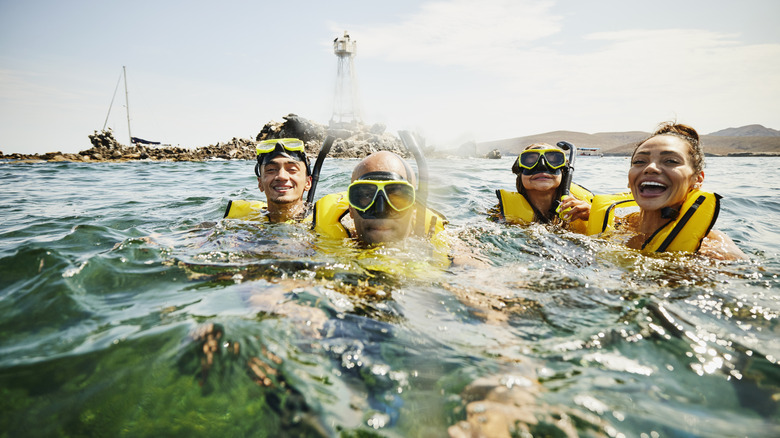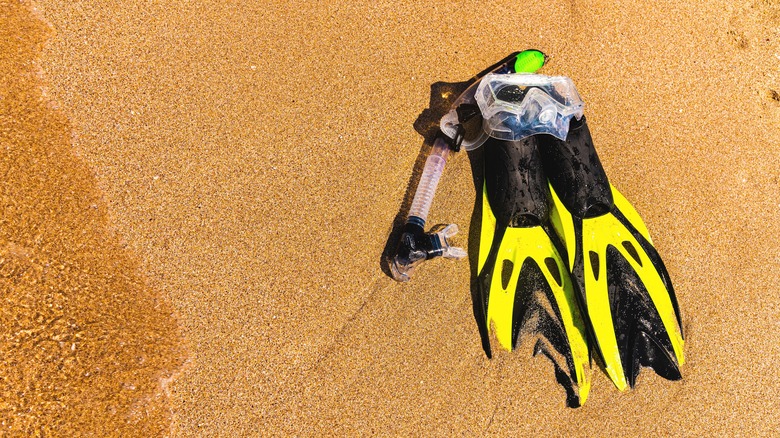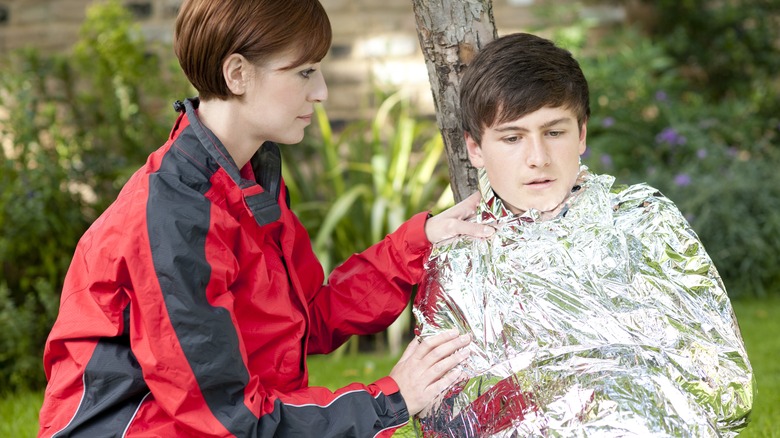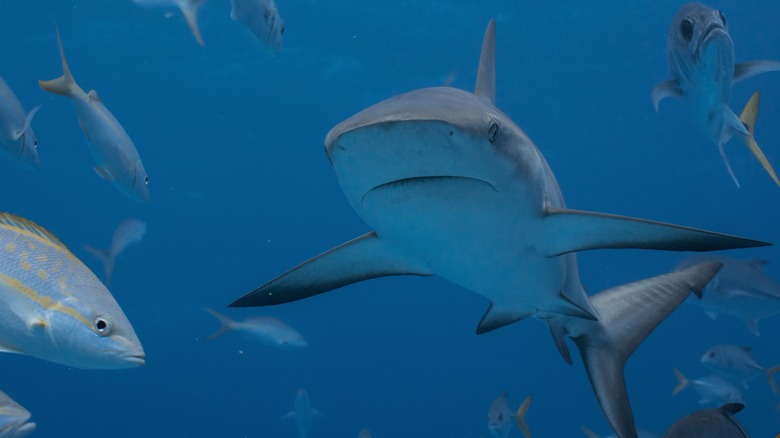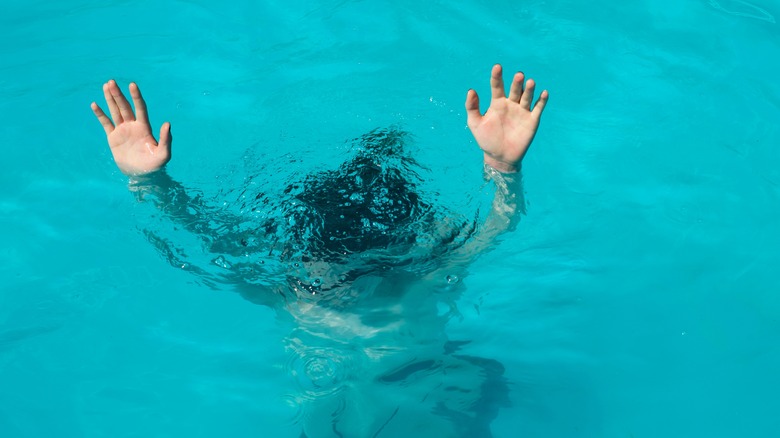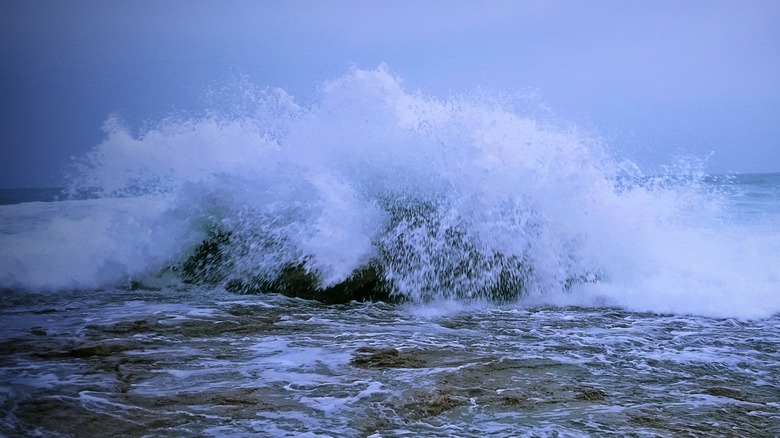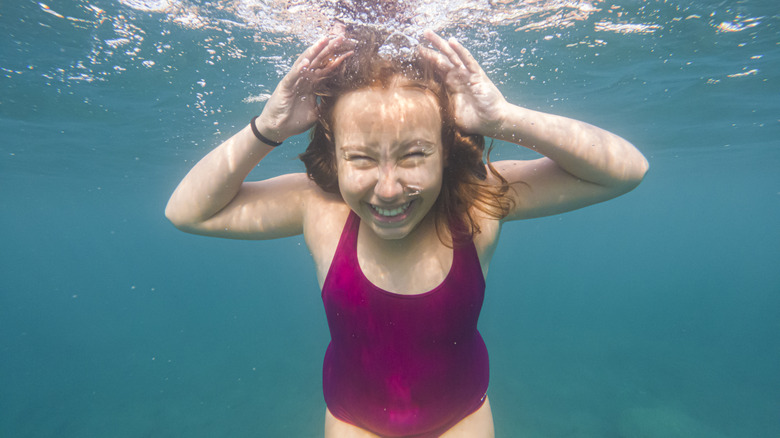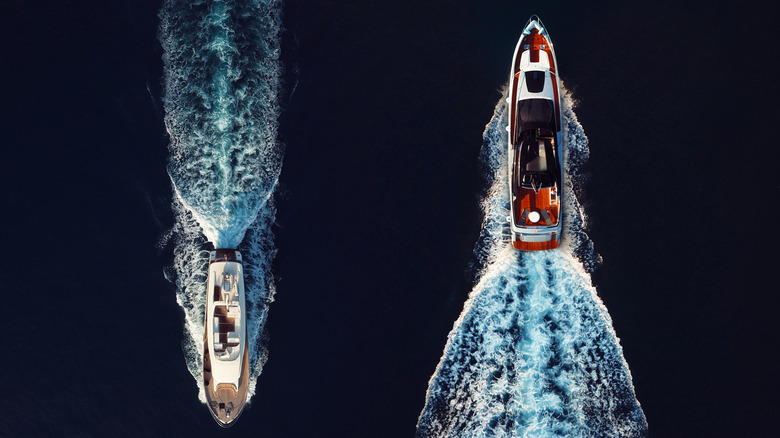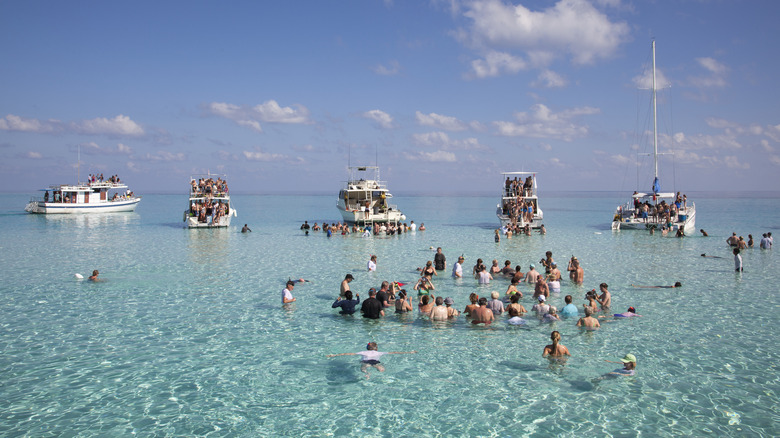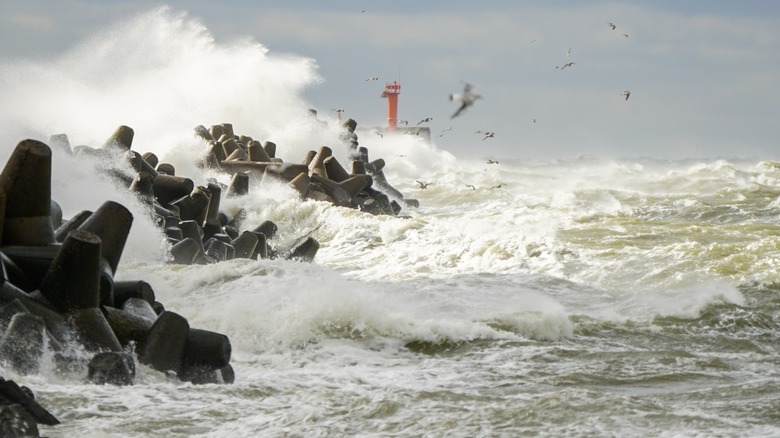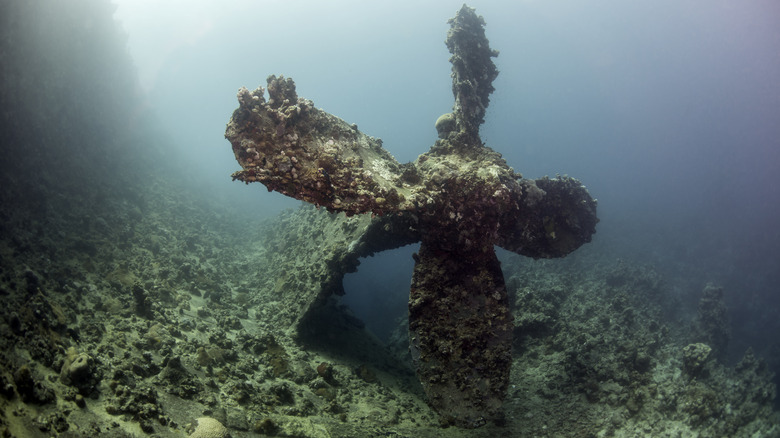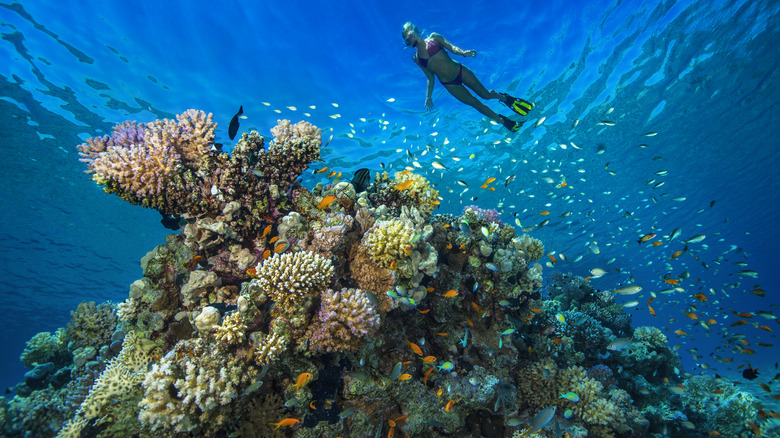Sneaky Dangers Of Snorkeling You Shouldn't Ignore
Travelers enamored by the rich array of life underwater are often drawn to snorkeling (and diving). It's a fun pastime that requires minimal training and equipment, bringing you close to, and in full focus of, the wildly electric, variegated hues and shapes of marine creatures. Strap on a mask, slide the snorkel into your mouth, slip into some fins, and suddenly, a whole new world is available for you to see. Maybe you'll have the good fortune of visiting the top snorkeling destinations in the U.S. or even the world's best islands for snorkeling.
Unlike diving, snorkeling doesn't come with limits as to how much time you can spend in the water and doesn't insist that you pass the requisite training. And yet, it's not completely danger-free. From gear that can make your experience in the water traumatic to the very real danger of death, snorkeling is an activity that needs to be approached with caution and diligence. The statistics make for harrowing reading — in Hawaii in 2017, 84 visitors died of drowning, and snorkeling was the most common activity during those incidents. That's not to say you should skip the chance to go snorkeling, but the very real dangers are not to be ignored.
Using faulty equipment
Your snorkeling experience should be remembered for the amazing sea life and coral you'll see under the water. Hopefully, you'll smile at the thought of the fan coral swaying in the current, or the graceful glide of an eagle ray, or perhaps the rainbow hues of a parrotfish. What you shouldn't recall is everything going wrong, and that's what will happen if you use sub-standard equipment. A snorkel tube, your main method of getting oxygen from the water surface, with a cracked or improper seal, will let in water, causing you to choke.
Additionally, a mask with a dried-out, brittle skirt won't adhere properly to your face and will allow water to stream in, impairing your vision and, possibly, stinging your eyes with salt water. Full-face masks, the type that is popular with snorkeling newbies, where the mask and snorkel tube are rolled into one unit, can actually be dangerous to use. If you need to swim in open water, this type of mask might fill up with carbon dioxide as you exert yourself, which can tire you out even more.
Getting dehydrated
You might think you can't get dehydrated in the water, but you'd be wrong. Snorkeling might seem like a pretty low-impact, easy-going activity, but it's also hard work, especially if the water is choppy. You are constantly kicking, breathing, working hard to stay afloat, and possibly using your arms to help you travel in the right direction. All that effort takes a toll, stripping your body of energy.
In the water, every time you exhale from your mouth, which you will have to do since you are using a snorkel to get air, you get a little more dehydrated. Suddenly, without realizing it, your mouth might feel parched, your head a little dizzy, and there is no water around for you to drink. If you are severely dehydrated, you can even pass out, which is bad anywhere but especially disastrous when you're in the water. Be sure to hydrate before any snorkeling excursion and plenty again after it's over.
Suffering from hypothermia
Swimming in the sea strips body heat many times faster than the air, and you can get cold very quickly. That's because heat transfers from your body and into water 20 times faster than it would if you were walking down the street. The same is also true if you're lounging about in 80-degree Fahrenheit water.
If, after being in the hot sun on a boat or while wading into the water from the shore, you feel a little chill upon entering, don't ignore it. It might be the first sign that your body is beginning to cool. From that point on, your body will be donating its heat via conduction and convection, as well as through expelling hot air into the surroundings, and that heat won't be replaced. To safeguard against this problem, consider wearing a wetsuit anytime you snorkel (even in warm water), which can insulate against heat loss. If you feel fatigued or notice chills gripping your body, exit the water immediately, and after drying off, put on warm clothing.
Falling victim to heat stroke
While hypothermia is a condition where your body temperature drops, heat stroke is the opposite, occurring when your body overheats. It's just as dangerous as hypothermia, and since snorkeling is frequently done in warm weather climates, it might even be more prevalent. Think about the last time you snorkeled. Were you out in the heat, exposed to the sun for many hours, not just in the water but also on the boat or dry land? All that heat takes its toll, gently cooking you until your insides start to bake and your body temperature climbs.
Symptoms of heat stroke can be dry, hot skin or damp, moist skin from excessive sweating, depending on how you get it. Either way, the effects can be devastating, from dizziness, confusion, and vomiting to lasting damage to the kidney, heart, and even brain. The key is to limit your exposure to the sun by staying in the shade or wearing clothing that protects you from it — broad-brimmed hats and rash vests in the sea are crucial. Staying hydrated to keep your core temperature cool is one of the best ways to avoid heat stroke when doing outdoor activities.
Injury through sea life
Snorkel enough times, and you'll realize that within the sea, there really is a world of wonder to discover. Colors seem more vibrant, almost alive, and fish and other marine creatures move in unpredictable ways that can be confounding, exciting, and poetic. But that beauty is sometimes laced with danger. Coral, the building block of aquatic life for many species, can be as sharp as a knife, and a cut from it is easy to get while snorkeling. It's also very painful and can take months to heal.
Sea urchins look a little like porcupines resting underwater, and their spines can easily pierce your foot. While that in itself can hurt enough to bring tears to your eyes, it can be accompanied by an infection, and in extreme cases, the urchin can even attack with venom that causes paralysis. And we haven't even started with the bigger creatures that roam the seas. Sharks are fearsome predators, and certain things attract sharks when you are swimming or snorkeling. Eels have powerful bites that can rip through human skin, while stingrays, of course, have a deadly stinging barb — the globally famous Australian conservationist Steve Irwin was killed by a stinger.
Actually drowning
While shallow-water blackouts have long been touted as one of the dangers of all diving formats, they also happen to snorkelers. The cause of it stems from the dilution of oxygen, or the build-up of carbon dioxide in your body, causing your system to temporarily shut down. In the water, such an event can be catastrophic, which means snorkelers face drowning risks even in shallow water.
Even sports people who spend many hours in the water aren't immune to this danger; the surfer Jay Moriarity died more than two decades ago in the Indian Ocean while snorkeling, and it's suspected he blacked out. The easiest way to stop this from happening is to always snorkel at the surface and resist the temptation to dive down underwater to take a closer look at the sea life. When you stick to the top of the water, the issue of reduced oxygen, or carbon dioxide saturation, ceases to become an issue.
Having a heart attack
While snorkeling might not be as strenuous as a speedy run or a thigh-burning cycle ride, it's still taxing on the body. And if you have cardiac issues or heart disease, then the chances of it inducing a heart attack on you are much higher. A 2012 study published in The Medical Journal of Australia looked into deaths caused by snorkeling from 1994 to 2006 and found that almost half of the 140 deaths were caused, or believed to have been caused, by cardiac arrest.
This doesn't mean that someone with a history of heart disease should forego the opportunity to go snorkeling, but they should be judicious in weighing the risks of such an excursion. Perhaps they could wear a life vest at all times in the water so they don't need to expend as much energy to keep afloat. And they should certainly refrain from diving below the surface, which requires greater exertion than just hanging out at the top.
Cramping up
We've all been in that situation, maybe when contorted like a pretzel while seated in an airline chair or standing in line at checkout in a grocery store when a muscle inexplicably tightens. It's a sudden, sharp sensation and can be very unnerving, but thankfully, it's easily remedied. An extension of the affected limb, a little stretch, and it's all gone. Cramps can occur through fatigue, poor muscle condition, or even dehydration (yet another reason to stay hydrated). While it's not usually a serious problem on land, it's a different story when you're in water.
Getting a cramp while snorkeling is hazardous; you'll lose control of your motions while you attend to the tight muscles. If the water is wavy, or you need to return to the boat, how can you do that if you aren't able to kick or move? Snorkeling does engage your whole body, and exhaustion can creep up on you very slyly. So, it's important that you take it easy and don't push past your limits. Stretch before you snorkel to warm your muscles.
Being swept away by currents
The sea is a powerful force, and let's be honest, you are no match for it. If the currents are strong, and you aren't prepared for them, you can quickly find yourself in places that you don't want to be. You might go out snorkeling near sea caves or a rocky shoreline, and suddenly, you're pushed toward land by a strong channel of water. At this point, you will have little control over where you'll end up, and that could be against some rocks or under the surface. Even the seemingly placid Caribbean Sea holds hidden dangers for anyone swimming.
If you are with a group, the guide will advise you on the currents and ensure that you snorkel in a location where the currents won't put you in danger. But if you take to the water independently, it's important that you analyze the water patterns beforehand to ascertain where it is safe to snorkel and where it is dangerous. You should also pay attention to the wind — it will create rough seas, which are never ideal for snorkeling — and surges of the water, which will carry you along with ridiculous ease, and not care where they dump you.
Having a panic attack
At its best, snorkeling can be exhilarating, the kind of activity that unshackles the dopamine in our body and sends it coursing through our system. But, especially if you are a novice at the pastime, it can also be terrifying. Really terrifying. Just take a minute to think about it, and you'll understand why. If you've taken a boat to get to a snorkel site, you'll likely be jumping into water and have vast tracts of open sea all around you. The ocean floor might be a long way down, and while there are coral and fish and larger marine creatures below, there are also endless expanses of nothing. Your mind starts to wander, and you imagine what might be in the water and if it will strike you as you flap about inefficiently.
These are all reasonable reactions, and having a panic attack might make you freeze in the water — there's an actual term for it, thalassophobia, or fear of large areas of open water — and that can spell disaster. If you feel that this might happen to you, start by snorkeling close to shore and see if you are comfortable with that before moving further from land.
The raw power of boat traffic
If you're snorkeling in open water far from shore, there will be boats around. That's a given; after all, you probably got to your location by boat. Even if you're snorkeling near the coastline, boats and jet skis might be zipping around in the waters nearby. Either way, these watercraft are big, bulky, and powerful, and if they hit you, the consequences could be fatal. If you're on a snorkeling tour, the boat captain and guide will scope out an area free of traffic, but it's still worth staying alert.
By the coast, where you might be setting out on an independent snorkel wander, it's up to you to gauge the situation and choose a safe site; maybe there is an area of water that is demarcated as off-limits to motorized water vessels. The reality is that snorkelers sometimes get hit, so try to be as visible as possible when in the water. This means wearing a brightly colored snorkel vest and attaching a dive flag or buoy to yourself to help boats see you.
The unpredictability of other snorkelers
Of all the hazards we've come across in our hundreds of hours of snorkeling all over the world, the most common has been other snorkelers. Sure, they are less likely to be life-threatening than an engine-powered marine vessel or a poisonous lionfish, but fellow snorkelers are sometimes such a pain. They can be pushy, unaware of their surroundings, and downright inconsiderate. They've shoved us, kicked us in the head, elbowed us in the ear, tugged on our fins, and grabbed us in sheer, uncontrolled panic.
Generally, inexperienced snorkelers display these traits. But it's hard to tell, when you're in a boat or paddling near the shore, who's a newbie snorkeler and who can glide around the open sea like a mermaid. Our advice is to try to stay as far away from other snorkelers as you can, though if you're on a tour, never stray too far from the flock.
Encountering bad weather
Snorkeling is best done when the sea is so still that it looks like a sheet of beautiful blue glass. That's when visibility will be high, kicking around the open water will be easy, and the whole excursion will showcase why snorkeling can be such a rewarding experience. But bad weather happens, and often you'll find yourself in rough seas, treading water in torrential rain (luckily, you won't be concerned about getting wet), and worrying about lightning, all factors that can make your snorkeling trip a living hell.
Snorkeling in the rain isn't a problem, though your visibility might be reduced because you won't enjoy direct sunlight filtering into the water. Rough seas, strong swells, unpredictable currents, and a thunderstorm moving in, however, are no joke. These conditions suggest you should postpone your snorkeling till another day.
Falling foul of underwater hazards
While boats whizzing on the water and frisky marine creatures below the surface are real dangers, they aren't the only things to look out for. You might encounter trash, old nets, metal pipes, and more underwater. And they can be just as dangerous to contend with as an aggressive seal or reckless jet ski rider. Fishing nets are strung in oceans all around the world, and some are left in the sea. Fish sometimes get caught in the nets — one estimate by the International Whaling Commission suggests that hundreds of thousands of whales and dolphins perish in these nets every year. You could just as easily get snagged in a net if you're not paying attention, though most snorkel operators will keep you away from them.
Old rusty shipwrecks and pipes sit underwater throughout the seven seas, and you can get cut or injured by getting too close to them. Ropes used to secure boats to shore are also hazardous, and getting caught in one can be uncomfortable. Floating plastic bags can easily attach themselves to the top of your snorkel, making it impossible to access air. So keep away from trash if you see it (better yet, grab it, stash it in a pocket, and dispose of it on land in a trash can).
Losing your group
When snorkeling with a group, it's not only reassuring to have others around you (unless they're the type of snorkeler mentioned earlier), but it's also safe. You can splash around in the knowledge that if anything happens, there are others who will help. Getting separated from your group can be extremely disturbing, and yet it is surprisingly easy to do. One minute, you're snorkeling, and the next, you see an interesting fish or a large turtle in the near distance. You kick toward it, and before you know it, you've caught up to it.
But you've also distanced yourself from the group, and when you look around, they are nowhere to be seen. This is a time when panic can set in because you have put yourself in real danger, alone out in the ocean. That's why you should always snorkel with a buddy and constantly monitor the group to be sure it is close by.
